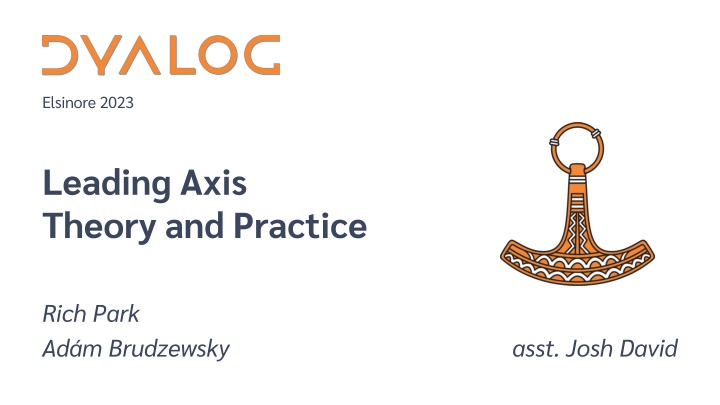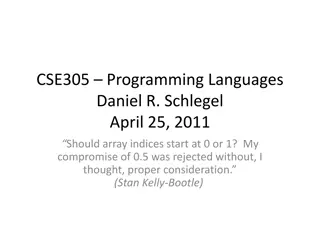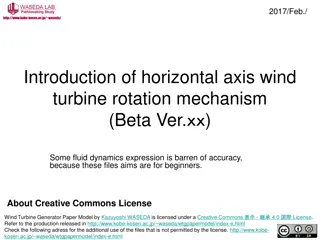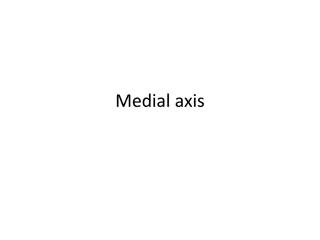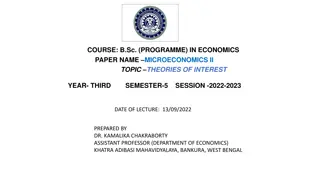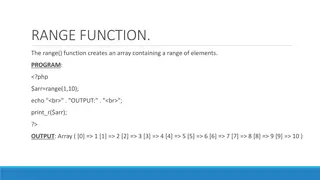Leading Axis Theory and Practice in Array Kingdom 2023
Exploring the concept of Leading Axis Theory and Practice in the Array Kingdom of Elsinore 2023. The discussion covers essential keys like Rank and Dyadic Transpose, Make Functions apply to whole arrays, and Theory Arrays of various ranks. The images provide insights into major cells, leading axes, and more, forming a comprehensive guide to understanding and implementing this theory for efficient array operations.
Uploaded on Sep 12, 2024 | 2 Views
Download Presentation

Please find below an Image/Link to download the presentation.
The content on the website is provided AS IS for your information and personal use only. It may not be sold, licensed, or shared on other websites without obtaining consent from the author.If you encounter any issues during the download, it is possible that the publisher has removed the file from their server.
You are allowed to download the files provided on this website for personal or commercial use, subject to the condition that they are used lawfully. All files are the property of their respective owners.
The content on the website is provided AS IS for your information and personal use only. It may not be sold, licensed, or shared on other websites without obtaining consent from the author.
E N D
Presentation Transcript
Elsinore 2023 Leading Axis Theory and Practice Rich Park Ad m Brudzewsky asst. Josh David
Rank and Dyadic Transpose are the Keys to the Array Kingdom Leading Axis Theory and Practice 1
Rank and Dyadic Transpose are the Keys to the Array Kingdom Leading Axis Theory and Practice 2
Leading Axis Overview Theory The Rank Operator Leading Axis Functions Leading Axis Operators Dyadic Transpose Performance Leading Axis Theory and Practice 3
Make Functions apply to Whole Arrays 1 1 1 2 1 3 ~ ~ ~ 2 1 2 2 2 3 ~ ~ ~ Leading Axis Theory and Practice 4
Make Functions apply to Whole Arrays 1 1 1 2 1 3 ~ ~ ~ 2 1 2 2 2 3 ~ ~ ~ Leading Axis Theory and Practice 5
Theory Array of rank 3 M N O P A A B B C C D D Q R S T E E F F G G H H U V W X L L I J K A 2 3 4 A Leading Axis Theory and Practice 6
Theory Array of rank 3 2-Cell: layer* M N O P A B C D Q R S T E F G H U V W X I J K L * Major cell A 2 3 4 A Leading Axis Theory and Practice 7
Theory Array of rank 3 2-Cell: layer* 1-Cell: row M N O P A B C D Q R S T E F G H U V W X I J K L * Major cell A 2 3 4 A Leading Axis Theory and Practice 8
Theory Array of rank 3 2-Cell: layer* 1-Cell: row 0-Cell: element M N O P A B C D Q R S T E F G H U V W X I J K L * Major cell Trailing axis A 2 3 4 A Leading Axis Theory and Practice 9
Theory Array of rank N K-Cell Major Cell Leading axis Trailing axis collection of arrays of rank N 1 sub-array of rank K N 1-Cell first dimension; list of major cells last dimension; list of scalar elements Leading Axis Theory and Practice 10
Discussion: Leading-Axis Primitives Functions Operators X Y X Y X Y X Y X Y @ Y X Y Y X Y Y Y Y Y X Y X Y Leading Axis Theory and Practice 11
The Rank Operator is just Blinkers Leading Axis Theory and Practice 12
The Rank Operator is just Blinkers Leading Axis Theory and Practice 13
The Rank Operator (fM) f sees arg of max rank M If necessary, f will be called multiple times Pro tip to avoid stranding of M and Y: (f M)Y or f( M)Y or f M Y Leading Axis Theory and Practice 14
Rank Values Sub-Arrays Elements/Scalars Rows/Vectors Layers/Matrices Blocks ... Rank 0 1 2 3 ... Leading Axis Theory and Practice 15
Task: Exchange the First Two Consider 'ABcdef' 'BAcdef' layers A 3 5 4 60 rows of each layer columns (elements of each row) Bonus question: How would you do it without ? Leading Axis Theory and Practice 16
The Rank Operator (fL R) f sees left arg of max rank L f sees right arg of max rank R If necessary, sub-arrays will be used multiple times Pro tips: If L and R are the same then f R is enough If confused, try { } L R Leading Axis Theory and Practice 17
Discussion: Whole Array Primitives Functions Operators A f X Y X Y f B Y A Y Y Leading Axis Theory and Practice 18
Task: Using L R names (,'Hey' 'Jay' .{ }'ley' 'den')[?10 4] Boolean vector indicating layers that are 2 3 'Heyley' Boolean matrix indicating rows that are 'Hey' Boolean rank-3 array indicating elements that are 'e' Bonus: Think about what the relationship is between and = Leading Axis Theory and Practice 19
Double-Rank ((fL2 R2)L1 R1) 'ABC'(, 0 1)'xy' Axy Bxy Cxy 'ABC'((, 0) 0 1)'xy' Ax Ay Bx By Cx Cy Remember: L=R Leading Axis Theory and Practice 20
Task: Using (L2 R2)L1 R1 A 1 10 100 B 2 3 4 24 Produce: 1 2 3 4 50 60 70 80 900 1000 1100 1200 13 14 15 16 170 180 190 200 2100 2200 2300 2400 Leading Axis Theory and Practice 21
Dyadic Transpose (XY): Why? Dyadic Transpose reorders axes Move axes to end, then use Rank on any function, operating on only those trailing axes Leading Axis Theory and Practice 22
Dyadic Transpose (XY): How? Reorders axes by the left argument: Each number is the destination index where we send that axis. 3 1 2 A 3rd 2nd dimension will be the 1st 1st dimension will be the 3rd dimension will be the 2nd Leading Axis Theory and Practice 23
Tasks: Merging Layers 1. horizontally: 2. vertically: 2 3 4 A ABCD EFGH IJKL ABCD EFGH IJKL MNOP QRST UVWX ABCDMNOP EFGHQRST IJKLUVWX MNOP QRST UVWX Leading Axis Theory and Practice 24
Transpose, Apply-with-Rank, Transpose Leading Axis Theory and Practice 25
Transpose, Apply-with-Rank, Transpose Leading Axis Theory and Practice 26
Keep Rank Close to the Primitives + Leading Axis Theory and Practice 27
Keep Rank Close to the Primitives + Leading Axis Theory and Practice 28
Task: Speed it Up! n ?1 10 100 1000 10 a '{+ 1 0 } d n' b ' your code here ' d 1 cmpx a b d 2 cmpx a b d 3 cmpx a b d 4 cmpx a b Leading Axis Theory and Practice 29
Task: Speed it Up! n ?1 10 100 1000 10 a '{+ 1 0 } d n' b ' your code here ' 'cmpx' CY'dfns' d 1 0 0 0 0.1 cmpx a b d 2 0 0 0 0.1 cmpx a b d 3 0 0 0 0.1 cmpx a b d 4 0 0 0 0.1 cmpx a b Leading Axis Theory and Practice 30
Lessons to Take Home Rank and Dyadic Transpose are the Keys to the Array Kingdom Make Functions apply to Whole Arrays The Rank Operator is just Blinkers Transpose, Rank-Apply-with-Rank, Transpose Keep Rank Close to the Primitives Leading Axis Theory and Practice 31
